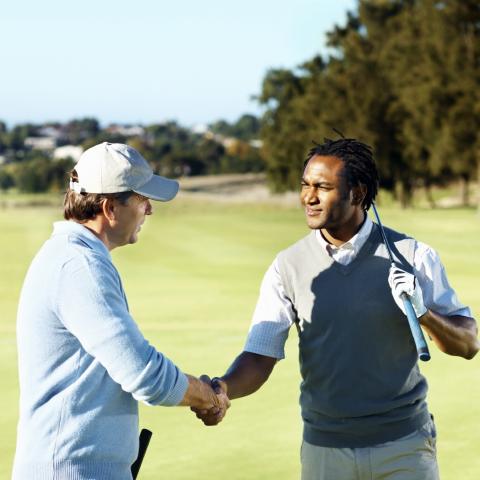Studying etiquette and manners is important, especially if you plan on visiting another country (and even more so if want to live there).
Above all else, it shows that you respect the country and its people enough to learn about how they live life and that you’re willing to adjust your own lifestyle as necessary. Further, knowing cultural etiquette and manners will allow you to more effectively communicate with people from that country, whether or not you’re actually visiting there. You’ll also find that when in a different country, knowing the proper etiquette will help you feel more comfortable and adapted (or at least like you’re not sticking out like a sore thumb).
And I’m sure we can all agree that finding yourself caught in a cultural taboo is like the worst thing that could happen to you. Especially if it all came about because you just didn’t know.
That said, EnglishClass101.com hopes to guide you through some of the most common and important aspects of etiquette in the United States. While I can’t cover everything (you probably wouldn’t stick around for an article that long anyway!), you’re sure to find some useful nuggets of United States etiquette information here.
Let’s get started with our guide to American culture and etiquette!
Table of Contents
- What is Etiquette?
- Speech Patterns to Discuss United States Customs and Etiquette
- Etiquette Rules in the United States
- Conclusion
1. What is Etiquette?
Etiquette is essentially a set of rules that a society follows because they’re seen as proper, right, and polite. It’s one of the many ways that a country or culture showcases and puts into practice its values and ideals. The same is true of United States etiquette culture.
Proper etiquette rules are definitely not the same around the world, and moving to a new country without knowing these etiquette rules and manners can make it a lot more stressful. Learning the proper etiquette of the country you’re visiting will not only make your visit so much smoother, but it shows that you respect that culture enough to make life more seamless for its people, too.
2. Speech Patterns to Discuss United States Customs and Etiquette
Before we get into all the do’s and don’ts of United States etiquette, let’s take a look at the basic sentence structures we’ll use to describe them in this article:
- You should ___
- Used to indicate something that you must do, or something that’s good to do.
- You should not ___
- Used to indicate something that you must NOT do, or something that’s rude to do.
- Do ___
- Used to indicate something that you must do, or something that’s good to do.
- Do not ___
- Used to indicate something that you must NOT do, or something that’s rude to do.
For instance, you may read in this article: “You should keep your mouth closed when chewing,” which means this is a good thing to do. Or you may read: “You should not talk on the phone at the table,” which means it would be rude to do this.
These are phrases you may hear in daily life as well (along with variations of them). For a country so open-minded, people sure do love to tell others what to do or not to do.
This out of the way, let’s move on to the actual etiquette rules and practices you’ll need to know before coming to the United States.
3. Etiquette Rules in the United States
Overall, the United States is pretty laid-back about minor etiquette rules. Further, the etiquette that’s expected of you has a lot to do with where in the United States you happen to be. It would be virtually impossible to come up with a master list of every single etiquette rule you may encounter, so we’ll only be covering United States social etiquette for situations you’re likely to find yourself in and which are pretty standard across the country. Let’s get started.
1- United States Dining Etiquette: Do’s and Don’ts for Dining
Are you really on vacation if you’re not eating out (or enjoying fabulous meals at a friend’s house)? Here, we’ll go over some basic dining and table etiquette that’s applicable whether in a restaurant, at a fast-food joint, or at someone’s house.
1. Ordering (at a Restaurant)
Do: You should be polite to your server. This includes offering them a simple greeting, such as “hi” or “hello.” Also keep in mind that your server may try to make light conversation by asking how your day is, or if you’re doing anything fun that day. You can simply reply with “good” or a short answer to the latter question.
Don’t: Depending on who you’re with, you shouldn’t order the most expensive thing on the menu. This can either indicate carelessness (if the other person or even a company is paying) or can be seen as snobbish (like you’re flaunting your money, especially around friends who may not make as much as you).
2. Eating (Anywhere)
Do: You should chew with your mouth closed, and attempt to chew quietly. This is considered polite and the best practice no matter where you’re eating. Keep in mind that sometimes you may find yourself dining with people who don’t follow this rule—in this case, how you chew is up to you.
Don’t: You shouldn’t talk on (or otherwise use) your cell phone at the table. This applies to both dining out, and dining in. It’s considered rude, as it makes you appear uninterested in the people you’re dining with. Further, it can be a distraction from the dining experience and can be very annoying. Unless it’s an emergency, do your best to keep your phone put away and out of sight.
3. Paying (at a Restaurant) & United States Tipping Etiquette
Do: You should leave your server a tip. In the United States, it’s considered very good practice to tip your waiter, especially considering that tips make up a good part of their earnings. This may even be considered a social etiquette, as opposed to only a dining etiquette. Tipping etiquette varies based on the type of restaurant you’re dining in, and on your own ability to tip. There’s no one-size-fits-all answer to tipping, so just leave your waiter or waitress an amount you feel comfortable with based on their service.
Don’t: You shouldn’t assume the person you’re with is paying for your meal. To be fair, dining out with someone can be ambiguous when it comes to the check. But unless the person (or company) you’re dining with has explicitly told you that they’re paying, be prepared to pay for your own meal.
2- Do’s and Don’ts for Sightseeing
The United States has so many beautiful places to visit, see, and explore. Whether you have plans for sightseeing or are invited to join someone on their own trip, there are a few etiquette rules you should be familiar with.
1. Sightseeing
Do: You should pay when it’s expected of you. Many sightseeing areas in the United States require that you pay a certain amount to enter. This is especially true of national parks, museums, and even smaller-scale parks and trails. If there’s no one actively working to receive your payment, you may be tempted to just not pay. But this is poor practice; not only is it rude, but you may also have your car towed and be expected to pay a fine if you’re caught (which will cost way more than the entrance fee!). Paying the fee is definitely the best way to go.
Don’t: You shouldn’t wander off anyplace that’s labeled as off-limits or disobey posted signs/warnings. Often, places you’re not allowed to wander to will be indicated with a sign saying “Prohibited.” You will get in trouble (possibly with the law) if you don’t heed these signs; this is called “trespassing,” and is something Americans despise. Other common signs you should watch out for are: “No walking on grass,” “Keep off ___,” “Don’t touch ___,” and “Don’t feed ___.”
2. Walking on Sidewalks/Streets
Do: You should always walk on the right-hand side of a sidewalk whenever possible. This allows for proper flow of foot traffic (people walking), and keeps people from running into each other when walking opposite directions.
You should also use crosswalks. We’ll get into this below in the “don’t” section.
Don’t: You shouldn’t “jaywalk.” Jaywalking is when you cross any road/street without using a crosswalk, where there’s one designated. Not only is this dangerous, but it’s illegal in many places. Be sure to watch for a crosswalk and use it anytime you need to cross a street.
3. Visiting a Church or Another Holy Place
Do: You should typically do whatever the rest of the congregation is doing if you’re invited to a church service (or an event at another holy place). The most important thing is to be respectful and courteous to those around you, which often (though not always) includes remaining quiet while a sermon or lesson is being given.
Don’t: Interrupt during a lesson or sermon. While people around you in the congregation may give short interjections in correspondence to what’s being said, it’s usually best to remain quiet and attentive during a sermon or lesson.
3- United States Meeting Etiquette: Do’s and Don’ts for Greetings
Don’t: You shouldn’t hug or kiss someone the first time you meet them. While this is commonplace in many countries, people in the United States tend to shrug away from physical contact on first meeting. It’s usually best to offer a handshake instead, if it seems appropriate. Also be sure not to crowd in too close when meeting someone—most Americans really want their space. In short, keep hugging, kissing, and closeness for good friends or family members.
Do: That said, you should smile and give your name. Many Americans are drawn to people with a cheery disposition, and of course they would like to know your name. This is considered a pretty standard form of greeting, with or without a handshake, depending on the situation.
Don’t: If you end up chatting with someone you’ve just met, you shouldn’t bring up personal details unless the other person brings up the topic. Many Americans get uncomfortable when people start giving them details about their lives. Further, it’s sometimes considered rude or unbecoming to ask details about their life, especially if it’s your first time meeting. Keep the conversations simple and light until the other person is ready to “break the ice,” and begin talking about personal details.
Do: In many cases, you should ask for their phone number or social media. If you’ve decided that the person you’ve met is a “keeper,” and someone you want to keep talking with in the future, go ahead and ask for this information. More likely than not, they’ll be glad to give you their number or social media. This is especially true for business environments, where it’s a good idea to have your colleagues’ contact info anyway.
4- Do’s and Don’ts for Visiting a House
Don’t: You shouldn’t stop by someone’s house uninvited. Most Americans (especially younger Americans) aren’t very keen on the idea of entertaining guests in their home, let alone someone who stops by unexpectedly. Americans also find it somewhat disrespectful to stop by without an invitation and much prefer to be notified in advance if you plan on visiting.
Do: When you’ve been invited to someone’s house, it’s usually good practice to stay with that person while you’re on their property. While there are exceptions (for instance, if you’re in a large group of people, you’re probably not expected to stay right with the person who invited you), Americans don’t really like their guests wandering around their home or property.
However, note that the rules here may change as your relationship with this person changes. The longer you know each other and the stronger your friendship/relationship grows, the more trust that person will have toward you. Once you’ve known each other a long time, they’ll probably be a lot more comfortable having you leave their side for a few minutes.
Don’t: You definitely shouldn’t “snoop” around someone’s home. As tempting as it is to read through their diary, go through all their photo albums, and check out that room they told you to never go in while they’re off to the bathroom for a few minutes, don’t do it. As a rule of thumb, if you’re not sure how they would feel about you touching or looking at something, just don’t do it.
Do: That said, you should always be mindful of that person’s belongings. Don’t touch what doesn’t belong to you, unless you have their explicit permission. If you accidentally break something or otherwise damage their property, be honest with them about it and offer to make up for the damage. Follow all of their house rules, and respect their wishes while you’re in their home.
5- Do’s and Don’ts for Public Transportation
1. When Riding a Bus
When riding a bus in the United States, there are quite a few etiquette rules you should be aware of and follow to the best of your ability. Here, we’ll start with the do’s and end with the don’ts.
Do: You should always pay as required by the bus. This may seem obvious, but it’s important to mention. Some buses will have you pay as you enter, and some also offer “passes” which you pay for once and get a certain number of rides from it. Paying for your seat on the bus is the number-one most important rule here.
Do: Once you’ve paid, you should find an available seat as quickly as possible. The faster you find a seat, the faster the people behind you can find their seat, and the less intrusive you’ll be to the people already seated. No dilly-dallying!
Do: You should be most courteous to elderly or disabled people and pregnant women. This means giving up your seat for them if there’s no room for them to sit, and also allowing them to exit the bus ahead of you.
Don’t: You shouldn’t ask someone to give up their seat for you. If all the seats are taken already, just stand and hold onto the poles to keep your footing. Note that there are exceptions to this rule; for instance, if you’re traveling with somebody and need to sit together, you can ask someone if they would mind moving over a seat so you can sit together. But as a general rule of thumb, you should let sitting people sit.
Don’t: You shouldn’t be too noisy while riding the bus. While “too noisy” will vary based on where you are in the United States, what bus line you’re riding with, and even the time of day, there are some general “rules” to keep in mind:
- Try to blend in with the amount of noise already on the bus.
- Don’t talk on the phone (unless other people are already talking).
- Don’t listen to loud music.
2. When Riding a Taxi
Most of the rules for riding a taxi are the same as those for riding the bus. However, there are a couple of unique English etiquette rules to keep in mind.
Do: You should greet your driver. A simple smile and “hello” before telling your taxi driver where you’re going will go a long way.
Don’t: As a general rule of thumb, you shouldn’t sit in the front seat with your taxi (or Uber or Lyft) driver. There’s no actual rule against doing this, and you won’t get in trouble, but it will make most drivers feel a little uncomfortable or awkward. It’s typically best to sit in the back seat.
3. When Riding on an Airplane
Do: You should board the plane when you’re supposed to (and only when you’re supposed to!).This refers both to the boarding time, and the group you’re supposed to board with. Be courteous to others—and keep from missing your flight—by being ready to board before boarding time. Also check your plane ticket to see which group you’re supposed to board with, and wait for that group to be announced before boarding.
Do: As mentioned before, Americans like to have their space. And most airplanes don’t have a lot of that. So, you should try and keep mostly to yourself while flying. There’s nothing wrong with a smile and a “hello,” with the person next to you, but be mindful not to invade their privacy. If they seem interested in having a chat, that’s awesome! Just be sure to keep your voice relatively quiet and follow their lead in the conversation.
Don’t: You shouldn’t sit anywhere on the plane except your assigned seat (which is usually printed on your ticket). Even if the plane is mostly empty, stay in your assigned seat. This is considered good practice, and makes life easier for the airplane staff and other passengers.
Don’t: You shouldn’t get up from your seat often. This is especially true if you happen to be sitting in the “window seat,” requiring the person in the “aisle” seat to get up so you can. Unless you really need to use the bathroom or have another important reason for getting up, stay in your seat and make everyone’s life easier!
6- United States Etiquette: Business Do’s and Don’ts
Visiting the United States on business? Here’s some basic United States business meeting etiquette, and etiquette rules for the office. Maintaining United States professional etiquette is always a plus.
Do: You should greet your colleagues with a handshake. A handshake is considered one of the most professional greetings, and accompanied by a polite “hello” or “Nice to meet you,” it will help you make a good first impression.
Don’t: You shouldn’t hug or otherwise touch your colleagues beyond a handshake. There are exceptions to this rule, but very few. Keeping it professional with a handshake is the safest route when it comes to greeting colleagues, especially for the first time.
Do: You should take notes during a business meeting, if it’s expected of you or you feel the need to. In most cases, this shows that you’re paying attention and are truly invested in the happenings of the meeting. (However, if you’re not supposed to be taking notes for whatever reason, don’t.)
Don’t: You shouldn’t do anything that would make you appear distracted. This includes “zoning out” and fidgeting. Do your best to stay focused on the discussion at hand and stay alert.
Do: You should negotiate and give your opinions, if you’re in a position to do so. This shows your involvement in a discussion, and can also be a great way to showcase your knowledge or expertise.
Don’t: While it’s good to give your opinions, you shouldn’t interrupt or over-exert yourself. Obviously, as with most etiquette rules, there are exceptions (in the United States, a common notion is that sometimes you just have to interrupt to be heard, and that’s okay). That said, too much interruption, or interrupting at the wrong time, can get you into trouble or keep people from taking you seriously. Further, you should keep it polite; don’t use profanity or talk down to people.
7- Do’s and Don’ts for Celebrations
Americans love celebrating, and there are a few events you’re likely to be invited to while in the United States. Here are some basic etiquette rules to keep in mind.
1. Wedding Etiquette
Do: You should dress nicely when attending someone’s wedding. For a female, this usually means a nice dress and shoes (at the minimum). For a male, this usually means a nice tux, shoes, and tie. Both males and females should do their best to appear well-groomed as well. However, don’t dress more nicely than the bride or groom.
Do: What else should you do at a wedding? Enjoy yourself! Most weddings are designed with guests’ enjoyment in mind, so showing that you’re having a good time will make a wonderful day even better for the bride and groom.
Don’t: While you should enjoy yourself, you definitely shouldn’t be disruptive in any way. Avoid drinking too much, getting into any kind of fight or argument, talking on the phone, or otherwise making the hosts or guests miserable.
2. Funeral Etiquette
Do: You should wear black (or gray) to funerals, unless told otherwise. Black is considered a color of mourning. By wearing black to a funeral, you’re both showing your own sorrow for the loss and expressing empathy for the people closest to the one who passed.
Do: You should remain somber during a funeral. While you don’t necessarily need to appear “sad” the whole time, especially if you didn’t know the person very well, it’s still important to show respect for the one who passed and those close to them by remaining somber.
Do: You should offer the family and friends of the deceased condolences if you have the opportunity to do so. You can say something along the lines of, “I’m sorry for your loss,” and your words will be much appreciated and taken to heart.
Don’t: You shouldn’t smile, laugh, or crack jokes when at a funeral. The last two in particular are considered very offensive and disrespectful (while smiling can be acceptable, for instance, if reflecting upon good memories of this person).
Don’t: This may seem very obvious, but we’ll say it anyway. When you’re at a funeral, you shouldn’t say anything bad or negative about the deceased person (or their family/friends). A funeral is a time of mourning loss and focusing on the good of the deceased person (as well as their legacy).
3. Housewarming Parties (or Other House Invitations)
Do: If you’re invited to a housewarming party (or baby shower/bachelor[ette] party/etc.), you should RSVP. This simply means to respond to the initial invitation by telling the person who invited you whether or not you’ll be coming. This is important as it allows for them to prepare for the appropriate number of people.
Do: Depending on the event and what the person who invited you is like, you should bring some sort of gift. If you’re not sure if a gift is required of you, you can ask the person who invited you, read through your invitation for more information, or ask someone else who’s attending. Usually, the gift doesn’t need to be something lavish or expensive; for a housewarming party, you may offer the person who invited you something to help them settle in better. For a baby shower, diapers, baby clothes, and other products the parents will need to care for their child are much appreciated. And, if in doubt, a gift card is the way to go.
Don’t: You shouldn’t linger too long at events like these. Usually, they can go on for a few hours and you won’t be rushed to leave. But there are a few signals to watch for that indicate it’s time to go:
- The host begins cleaning up.
- Other people begin to leave and the crowd dwindles.
- The host says that the event is over, or thanks everyone for attending.
Enjoy yourself and celebrate the host’s next step in life, but don’t overstay your welcome.
8- Do’s and Don’ts for Email and the Internet
Email etiquette in the United States is a vital topic to cover, considering how deeply ingrained email communication has become in the U.S. workplace and in Americans’ personal lives. Here are some do’s and don’ts for email etiquette.
1. Email Etiquette
Do: When emailing, especially for business purposes, you should keep it formal and polite. Address the person or people you’re emailing by name, get straight to the point, and end the email with a good wish and your name. And keep the content respectful.
Don’t: You should never spread gossip, use diminutive language, or say anything in an email that you don’t want other people to see. This is bad email etiquette, and is sure to backfire at some point. Keep your emails polite, courteous, and professional.
2. Internet Comment Etiquette
Social media, social media. It can be used for good and for evil, and unfortunately most internet comments reflect the latter. To avoid bad internet comment etiquette, here are some do’s and don’ts to keep in mind.
Do: You should share your opinion on topics in a courteous manner. Always keep in mind that there’s more than one side to any story, and that no two people in the world think or feel completely the same way. And that’s fine.
Don’t: You shouldn’t (Read: Please don’t!) start fights or say anything hateful online. As a certain rabbit in a certain Disney film once said, “If you can’t say something nice, don’t say nothin’ at all.”
9- Actual Laws and Other Taboos
Now we get to the fun stuff. The stuff, in this case, that you really shouldn’t do. In other words, our list of “definitely don’ts.”
1. Smoking
In general, smoking in the United States isn’t too heavily regulated. However, here are some things to keep in mind:
- In most states in the U.S., you must be at least eighteen years old to smoke or purchase smoking products. You can get in a lot of trouble for smoking if you’re not at this legal age, and even more trouble for selling to someone under eighteen.
- Many places in the United States have “smoke-free” or “no-smoking” areas. These are usually indicated by a sign of a cigarette in a red, crossed-out circle. Don’t smoke when you see a sign like this.
- What you smoke is very important. While cigarettes, tobacco, vapes, and (in only a few states) marijuana are usually acceptable, there are some things that are illegal to smoke in the United States.
It’s a good idea to brush up on more specific smoking laws before coming to the United States, as this will make your stay a lot easier.
2. Drinking
Drinking is a common past-time of many people in the United States. But keep in mind that the legal drinking age in the United States is twenty-one. It’s illegal to drink alcohol if you’re under this age, and illegal to sell it to someone under this age. You can also get in trouble for buying alcohol for someone under twenty-one.
3. Parking
Parking your vehicle in the United States is a pretty big deal, especially when it’s done illegally. Some of the most important things to remember are:
- Don’t park in a handicap space, unless you are considered handicapped and have a sign or license plate to prove it. (Handicap spots are marked by a handicap sign and a painting on the pavement of a person in a wheelchair.)
- Don’t park in front of fire hydrants, red curbs, or loading zones.
- Don’t park in a space for longer than the allotted amount of time, if there’s a sign telling you how long you can park there.
- Follow assigned parking rules, if there are any.
- Pay to park when needed. This can be at a parking meter (those pesky things!), or an actual person (usually at national parks or other significant landmarks).
- Don’t park too close to another vehicle—be sure to give them plenty of room to open their car doors, back out, etc.
There are other parking etiquette rules to consider, but knowing these should be enough to keep you out of parking trouble. Failure to follow some of these rules can result in a fine (or, worst-case scenario, your vehicle being towed!).
4. Marriage and Other Romantic Relationships
Laws about marriage and other romantic relationships in the United States are very strict, especially when it comes to the age factor. Specific laws vary by state.
When it comes to any kind of sexual relationship or behavior, each state has a set age of consent. In most states, this is age sixteen, seventeen, or eighteen. Engaging in sexual behavior with someone under the age of consent is illegal.
4. Conclusion
Do you feel like you have a better idea of proper etiquette in the United States now and can avoid bad manners? We know that etiquette rules can be some of the hardest to grasp, as they’re deeply rooted in culture and can vary widely from one place to another. But that also makes them so important.
Does your own country have similar etiquette and manners? Or is proper etiquette there totally different? Let us know!
If you want to learn more about United States culture and the English language, visit us at EnglishClass101.com. We offer an array of insightful blog posts like this one, free vocabulary lists, and an online community to discuss lessons with fellow English learners. You can also upgrade to Premium Plus in order to use our MyTeacher program and learn with your own personal English teacher.





















